
The Drivers, Implications and Outlook for China’s Shrinking Current Account Surplus
China’s current account surplus has declined significantly from its peak in 2008 and the external position in 2018 was in line with medium-term fundamentals and desirable policies. While cyclical factors and expansionary credit and fiscal policies contributed, the trend decline has been largely structural, driven by economic rebalancing from investment to consumption, appreciation of the real effective exchange rate (REER) towards equilibrium, increase in outbound tourism, and moderation in goods surplus reflecting market saturation and China’s faster growth compared with trading partners. Policies should focus on continued rebalancing and opening up to ensure excessive surpluses do not return, and to prepare the economy and the financial system to handle more volatile capital flows. From a global perspective, the decline in China’s surplus has lowered global imbalances, but with different impact across countries. The analysis is based on data as of July 2019.
Publication date: November 2019
ISBN: 9781513516097
$18.00
Add to Cart by clicking price of the language and format you'd like to purchase
Available Languages and Formats
| English |
Prices in red indicate formats that are not yet available but are forthcoming.
Topics covered in this book
This title contains information about the following subjects.
Click on a subject if you would like to see other titles with the same subjects.
global value chains , global imbalances , , WP , account surplus , current account surplus , trade balance , global GDP , social safety net
Summary
Copyright © 2010 - 2024
Powered by:
AIDC



